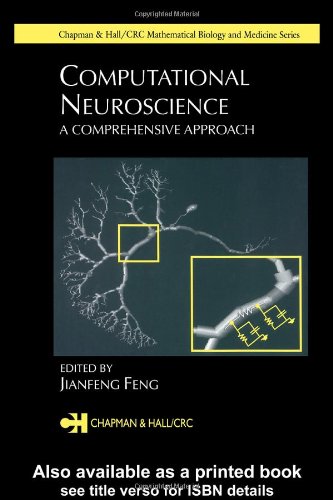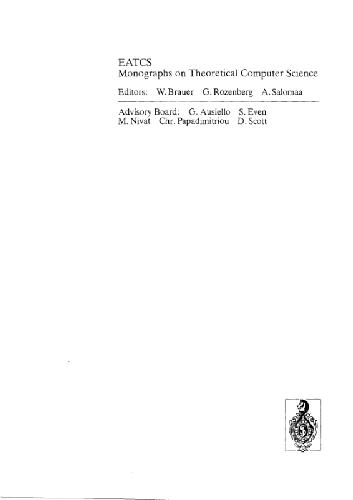Jianfeng Feng9781584883623, 1-58488-3626
Table of contents :
Contents……Page 5
Preface……Page 15
1.1 Introduction……Page 23
1.2.1 Basic notation and techniques……Page 24
1.2.2 Single neuron modelling……Page 26
1.2.3 Phase model……Page 28
1.3.1 Jump processes……Page 29
1.3.2 Diffusion processes……Page 32
1.3.4 Perturbation of deterministic dynamical systems……Page 35
1.4.1 Shannon information……Page 38
1.4.3 Fisher information……Page 39
1.4.4 Relationship between the various measurements of information……Page 40
1.5.1 Optimal control of movement……Page 41
1.5.2 Optimal control of single neuron……Page 43
References……Page 46
2.1.1 Scope of this chapter……Page 53
2.1.2 Ion channels……Page 54
2.2 Simulation methods……Page 59
2.2.1 Molecular dynamics……Page 61
2.2.2 Continuum electrostatics……Page 65
2.2.3 Brownian dynamics……Page 67
2.3.1 Simplified systems……Page 69
2.3.2 Gramicidin A……Page 71
2.3.3 Alamethicin……Page 72
2.3.4 OmpF……Page 75
2.3.5 The potassium channel KcsA……Page 79
2.4 Outlook……Page 85
References……Page 87
3.1 Introduction……Page 96
3.2 Basic principles……Page 98
3.2.1 Intracellular calcium stores……Page 100
3.2.3 Calcium pumps and exchangers……Page 102
3.2.4 Mitochondrial calcium……Page 103
3.3 Special calcium signaling for neurons……Page 105
3.3.1 Local domain calcium……Page 106
3.3.2 Cross-talk between channels……Page 108
3.3.3 Control of gene expression……Page 110
References……Page 112
4.1 Introduction……Page 117
4.2.1 Equations governing NO diffusion in the brain……Page 120
4.2.2.1 Modelling NO diffusion from a point-source……Page 122
4.2.2.2 Modelling NO diffusion from a symmetrical 3D structure……Page 123
4.2.2.3 Numerical integration of analytical solutions……Page 126
4.2.3.1 Finite difference methods for diffusive problems……Page 128
4.2.3.2 Finite difference schemes used……Page 131
4.2.4.1 Diffusion coefficient and decay rate……Page 132
4.2.4.2 NO production rate……Page 133
4.3 Results……Page 134
4.3.1 Diffusion from a typical neuron……Page 135
4.3.2 Effect of neuron size……Page 138
4.3.3 Small sources……Page 139
4.4 Exploring functional roles with more abstract models……Page 144
4.4.2 Gas diffusion in the networks……Page 145
4.4.3 Modulation……Page 146
References……Page 147
5.1 Introduction……Page 151
5.3 Single channel models……Page 154
5.3.1 A three-state mechanism……Page 155
5.3.2 A simple channel-block mechanism……Page 156
5.3.3 A five-state model……Page 157
5.4 Transition probabilities, macroscopic currents and noise……Page 159
5.4.1 Transition probabilities……Page 160
5.4.2 Macroscopic currents and noise……Page 161
5.5.1 The duration of stay in an individual state……Page 162
5.5.2 The distribution of open times and shut times……Page 164
5.5.3 Joint distributions……Page 166
5.5.4 Correlations between intervals……Page 167
5.5.5 Bursting behaviour……Page 168
5.6 Time interval omission……Page 169
5.7.2 Hidden Markov Methods of analysis……Page 171
References……Page 172
6.1 Introduction……Page 179
6.2 Typical input is correlated and irregular……Page 180
6.3 Synaptic unreliability……Page 181
6.4 Postsynaptic ion channel noise……Page 183
6.5 Integration of a transient input by cortical neurons……Page 185
6.6 Noisy spike generation dynamics……Page 188
6.7 Dynamics of NMDA receptors……Page 191
6.8 Class 1 and class 2 neurons show different noise sensitivities……Page 193
6.9 Cortical cell dynamical classes……Page 194
6.10 Implications for synchronous firing……Page 196
References……Page 198
Generating Quantitatively Accurate, but Computationally Concise, Models of Single Neurons……Page 205
7.1.1 The scale of the problem……Page 206
7.1.2 Strategies for developing computationally concise models……Page 209
7.2 The hypothalamo-hypophysial system……Page 210
7.2.1 Firing patterns of vasopressin neurons……Page 211
7.2.2 Implications of membrane bistability for responsiveness to afferent input……Page 213
7.2.4 Intrinsic properties……Page 214
7.2.5 Intracellular Ca2+ concentration……Page 216
7.3.1 Selecting recordings for analysis……Page 217
7.3.3 Modelling……Page 218
7.3.4 Simulating oxytocin cell activity……Page 219
7.3.5 Experimental testing of the model……Page 221
7.3.6 Firing rate analysis……Page 223
7.3.7 Index of dispersion……Page 225
7.3.8 Autocorrelation analysis……Page 226
7.4 Summary and conclusions……Page 227
References……Page 232
Bursting Activity in Weakly Electric Fish……Page 234
8.1.1 What is a burst?……Page 235
8.2 Overview of the electrosensory system……Page 236
8.2.2 Neuroanatomy of the electrosensory system……Page 239
8.2.3 Electrophysiology and encoding of amplitude modulations……Page 241
8.3.1 Bursts reliably indicate relevant stimulus features……Page 242
8.3.2 Feature extraction analysis……Page 244
8.4 Factors shaping burst firing……Page 248
8.5.1 Experimental evidence for conditional backpropagation……Page 250
8.5.2 Multicompartmental model of pyramidal cell bursts……Page 252
8.5.3 Reduced models of burst firing……Page 254
8.6 Comparison with other bursting neurons……Page 257
8.6.1 Ping-pong between soma and dendrite……Page 258
8.6.2 Dynamical properties of burst oscillations……Page 259
8.7 Conclusions……Page 260
References……Page 262
9.1 Introduction……Page 272
9.2.1 The conditional intensity function and interspike interval probability……Page 274
9.2.2 The likelihood function of a point process model……Page 277
9.2.3 Summarizing the likelihood function: maximum likelihood estimation and Fisher information……Page 279
9.2.4 Properties of maximum likelihood estimates……Page 280
9.2.5 Model selection and model goodness-of-fit……Page 281
9.3.1 An analysis of the spiking activity of a retinal neuron……Page 282
9.3.2 An analysis of hippocampal place-specific firing activity……Page 289
9.3.3 An analysis of the spatial receptive field dynamics of a hippocampal neuron……Page 295
9.4 Conclusion……Page 301
9.5 Appendix……Page 302
References……Page 303
10.1 Introduction……Page 306
10.2 Cells……Page 308
10.2.2 Modelling cerebellum neurons……Page 309
10.3 Synapses……Page 310
10.4.1 Network topology……Page 311
10.4.2 Number of connections……Page 312
10.4.3 Distribution of connections……Page 313
10.5.1.1 Spatial pattern of OB inputs……Page 316
10.5.2 Inputs to individual cells……Page 317
10.5.2.3 Current pulses……Page 318
10.7 Validation……Page 319
References……Page 320
11.1 Hebbian models of plasticity……Page 324
11.2 Spike-timing dependent plasticity……Page 326
11.3 Role of constraints in Hebbian learning……Page 328
11.3.2 Constraints based on postsynaptic rate……Page 329
11.3.3 Constraints on total synaptic weights……Page 330
11.4.1 STDP is stable and competitive by itself……Page 332
11.4.2 Temporal correlation between inputs and output neuron……Page 333
11.4.3 Mean rate of change in synaptic strength……Page 334
11.4.4 Equilibrium synaptic strengths……Page 336
11.4.5.1 Constant Poisson inputs……Page 338
11.4.5.2 Correlations with different time constants……Page 342
11.4.5.3 Gradient of correlations……Page 343
11.5 Temporal aspects of STDP……Page 345
11.6.1 Hebbian models of map development and plasticity……Page 346
11.6.2 Distributed synchrony in a recurrent network……Page 350
11.7 Conclusion……Page 351
References……Page 352
12.1 Introduction: the timing game……Page 359
12.2.1 Stimulus representation……Page 361
12.2.2 Information flow……Page 363
12.3 Correlations arising from common input……Page 365
12.4 Correlations arising from local network interactions……Page 368
12.5 When are neurons sensitive to correlated input?……Page 371
12.5.2 Fluctuations and integrator models……Page 372
12.6.1 Parameterizing the input……Page 375
12.6.2 A random walk in voltage……Page 377
12.6.3 Quantitative relationships between input and output……Page 380
12.7 Correlations and neuronal variability……Page 382
12.8 Conclusion……Page 383
References……Page 385
13.1 Introduction……Page 393
13.2.1 Quantifying neuronal responses and stimuli……Page 394
13.2.2 Mutual information and sampling bias……Page 395
13.2.3 Series expansion approach to information estimation……Page 396
13.2.3.2 PSTH Similarity……Page 397
13.2.3.4 Stimulus-independent spike patterns……Page 398
13.2.4 Generalised series expansion……Page 399
13.3.1 Whisking behaviour……Page 400
13.3.2 Anatomy of the whisker system……Page 401
13.4.1 Introduction……Page 402
13.4.2 Role of spike timing……Page 403
13.4.2.2 Role of spike patterns……Page 404
13.4.2.4 Pooling……Page 406
13.5.1 Decoding first spike times……Page 407
13.5.2 Role of cross-correlations in population codes……Page 408
13.6 Conclusions……Page 410
References……Page 411
14.1 The fly motion vision system: an overview……Page 414
14.2 Mechanisms of local motion detection: the correlation detector……Page 417
14.2.1.1 Velocity tuning……Page 418
14.2.1.2 Pattern dependence……Page 419
14.2.1.3 Orientation tuning……Page 422
14.2.2 Dynamic response properties……Page 423
14.2.3 Additional filters and adaptive properties……Page 425
14.3.1 Compartmental models of tangential cells……Page 428
Figure 14.10……Page 429
14.3.2 Dendritic integration and gain control……Page 431
Figure 14.12……Page 433
14.3.3 Binocular interactions……Page 434
14.3.4 Dendro-dendritic interactions……Page 435
Figure 14.13……Page 436
Figure 14.14……Page 437
14.4 Conclusions……Page 438
References……Page 440
Mean – Field Theory of Irregularly Spiking Neuronal Populations and Working Memory in Recurrent Cortical Networks……Page 447
15.1 Introduction……Page 448
15.2.1 The leaky integrate-and-fire neuron……Page 450
15.2.2 Temporal structure of the afferent synaptic current……Page 451
15.2.3 The diffusion approximation……Page 452
15.2.4 Computation of the mean firing rate and CV……Page 455
15.2.5 Effect of synaptic time constants……Page 459
15.2.6 Approximate treatment of realistic synaptic dynamics……Page 461
15.3.1 Self-consistent steady-state solutions in large unstructured networks……Page 468
15.3.2 Stability and dynamics……Page 475
15.3.3 Bistability in a single population network……Page 479
15.3.4 Persistent neural activity in an object working memory model……Page 484
15.3.5 Stability of the persistent activity state……Page 485
15.3.6 Multistability in balanced networks……Page 490
15.4 Summary and future directions……Page 494
Appendix 1: The diffusion approximation……Page 495
Appendix 2: Stability of the steady-state solutions……Page 497
References……Page 498
The Operation of Memory Systems in the Brain……Page 507
16.2 Functions of the hippocampus in long-term memory……Page 508
16.2.1 Effects of damage to the hippocampus and connected structures on object-place and episodic memory……Page 509
16.2.2 Neurophysiology of the hippocampus and connected areas……Page 511
16.2.3 Hippocampal models……Page 514
16.2.4 Continuous spatial representations, path integration, and the use of idiothetic inputs……Page 516
16.2.5 A unified theory of hippocampal memory: mixed continuous and discrete attractor networks……Page 526
16.2.6 The speed of operation of memory networks: the integrate-and- fire approach……Page 527
16.3.1 Prefrontal cortex short-term memory networks, and their relation to temporal and parietal perceptual networks……Page 528
16.3.2 Computational details of the model of short-term memory……Page 530
16.3.3 Computational necessity for a separate, prefrontal cortex, shortterm memory system……Page 534
16.3.5 Synaptic modification is needed to set up but not to reuse shortterm memory systems……Page 535
16.4 Invariant visual object recognition……Page 536
16.5 Visual stimulusÒreward association, emotion, and motivation……Page 537
16.6 Effects of mood on memory and visual processing……Page 538
References……Page 541
Modelling Motor Control Paradigms……Page 551
17.1 Introduction: the ecological nature of motor control……Page 552
17.2.1 Logical decomposition of motor control into cascaded computational……Page 555
17.2.2 The Achilles’ heel of feedback control……Page 557
17.3.1 Motor equivalence and spatio-temporal invariances……Page 560
17.3.2 The viscous-elastic properties of the human muscles……Page 564
17.3.3 Dynamic compensation: anticipatory feedforward and feedback……Page 565
17.4 The role of cerebellum in the coordination of multiple joints……Page 566
17.4.1 Abnormal feedforward control in ataxic patients……Page 569
17.5.1 Stabilisation of the standing posture: evidence of anticipatory compensation……Page 572
17.5.2 Arm trajectory in a divergent force field: evidence of stiffness modulation……Page 575
17.5.3 Choosing between stiffness modulation and anticipatory compensation……Page 576
17.5.4 Implementing anticipatory compensation……Page 578
17.6.2 Adaptive behaviour and motor learning……Page 581
17.6.3 A distributed computational architecture……Page 582
References……Page 585
18.1 Introduction……Page 590
18.2 A conceptual framework for real-time neural computation……Page 591
18.4 Towards a non-Turing theory for real-time neural computation……Page 597
18.5.1 Speech recognition……Page 599
18.5.2 Predicting movements and solving the aperture problem……Page 604
18.6.1 Temporal integration in neural microcircuit models……Page 609
18.6.2 Kernel function of neural microcircuit models……Page 614
18.7 Software for evaluating the computational capabilities of neural microcircuit models……Page 615
18.8 Discussion……Page 616
References……Page 618
19.1 Introduction……Page 621
19.2 Brain areas……Page 622
19.3.1 Visual search and pop-out……Page 624
19.3.2 Computational models and the saliency map……Page 625
19.4.1 Are we blind outside of the focus of attention?……Page 628
19.4.2 Attentional modulation of early vision……Page 629
19.5.2 Influence of task……Page 630
19.6 Attention and scene understanding……Page 631
19.6.2 Cooperation between where and what……Page 632
19.7 Discussion……Page 633
References……Page 636
CONTRIBUTORS……Page 20







Reviews
There are no reviews yet.